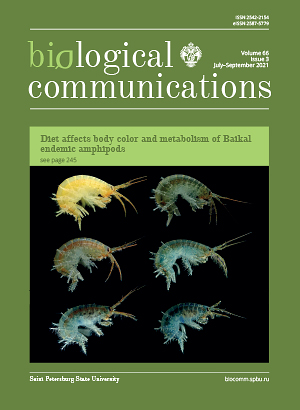Diet affects body color and energy metabolism in the Baikal endemic amphipod Eulimnogammarus cyaneus maintained in laboratory conditions
DOI:
https://doi.org/10.21638/spbu03.2021.306Abstract
Proper diet is critical for laboratory-reared animals, as it may affect not only their welfare, but also experimental results. Amphipods (Crustacea: Amphipoda) play important roles in ecosystems and are often used in environmental research. Endemic amphipods from the ancient Lake Baikal are promising for laboratory bioassays; however, there are currently no laboratory cultures. In this work, we determine how different diets affect the color and metabolism of a laboratory-reared Baikal amphipod, Eulimnogammarus cyaneus. We found that in freshly collected blue-colored animals, body color correlated with total carotenoid content. Total carotenoid levels did not differ after long-term (two months) feeding with a close to natural carotenoid-enriched, or even a carotenoid-depleted diet. Nevertheless, antennae color was closer to red in the natural-like diet group. It is likely that the carotenoids from the commercial diet are not properly metabolized in E. cyaneus. The animals fed commercial diets had a higher glycogen content, which may signify a higher metabolic rate. Overall, we show that a carotenoid-enriched diet optimized for decapods is not optimal for amphipods, likely due to different carotenoid compositions, and the diet for long-term rearing of E. cyaneus and other Baikal amphipods requires supplementation.
Keywords:
carotenoids, diet, laboratory rearing, Baikal, Amphipoda, Crustacea, Decapoda, culture, metabolites
Downloads
References
Downloads
Additional Files
Published
How to Cite
License
Articles of Biological Communications are open access distributed under the terms of the License Agreement with Saint Petersburg State University, which permits to the authors unrestricted distribution and self-archiving free of charge.





